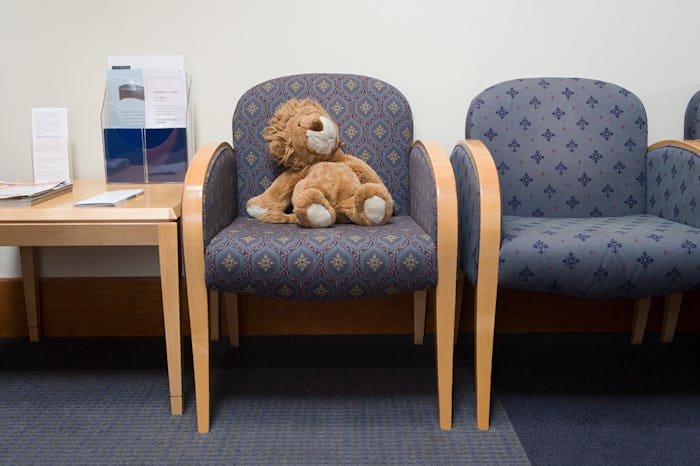Life
The AAP's New Guidelines For Pediatric Waiting Rooms Will Help Keep Everyone Healthier
There is nothing worse than the waiting room of a doctor's office, let alone the pediatrician's office. Between the wait times to the other sick people around you, the waiting room gives you a really good time for self reflection. Does your kid sound as bad as the other sick kids? Should your kid really be seen by the doctor now? And is there any way for you to get sick from the other clearly sick people milling around you? These questions are common, but the American Academy of Pediatrics' new pediatric waiting room guidelines will hopefully put your mind at ease during your next visit to the doctor's office.
The AAP's new guidelines are specifically for pediatrician's offices, according to Scary Mommy, putting them up to the standards of hospital waiting rooms to avoid the contamination of germs. The guidelines don't pertain to just the doctors offices, they pertain to patients, too. Both pediatricians and parents can work to make sure that germs are contained, keeping kids relatively germ free. These new guidelines from the AAP will make parents feel safer to walk into the waiting room with a sick kid — and this is because your pediatrician will now have to abide by the guidelines.
The following are some of the standouts from the updated guidelines that parents will need to know about.
Everyone Must Wash Their Hands
This is a given in almost any industry. You've seen the signs hanging up in your Starbucks bathroom — "all employees must wash their hands before returning back to work." But in a pediatrician's office, this can save lives. According to the AAP, hand hygiene (aka washing your hands with soap and water or alcohol based hand sanitizer) is the single most important way of preventing anyone from getting sick.
The AAP advises that anyone in the medical industry, dealing with a patient, should wash their hands and keep them clean. That applies not only for medical professionals, but for parents of sick children, too.
Etiquette Is Key
The guidelines emphasize that doctors offices should encourage patients to adhere to "cough etiquette principals" and the resources to do so.
This means, according to the guidelines, that doctors offices should provide masks for the patients who are coughing so they don't spread their germs everywhere, in addition to providing tissues and the proper place to dispose them, and directing patients to cough into their arms and not into the open. According to the guidelines, doctors offices also should provide alcohol-based hand sanitizer for patients to use at any time to prevent the spread of germs.
The Flu Vaccine Is Mandatory For Staff Members
Say what you want about the flu vaccine, but it, too, saves lives. The Centers for Disease Control and Prevention found that over a four-year period, the flu shot reduced the risk of flu associated death by 51 percent. The flu shot prevents people from getting the flu and giving it to other people.
The AAP's new guidelines now require all staff members of pediatricians offices to have the flu shot, as well as the paperwork for shots for other vaccine preventable diseases. This, of course, could reduce the risk of people spreading a preventable disease, like the flu, to your child. With as many people as a nurse may come in contact with a day, the last thing you want is for them to be sick. This ensures that they won't.
Goodbye, Furry Friends
Preventing the spread of disease not only pertains to medical professionals, it also pertains to the items in the doctor's office. According to the AAP's new guidelines, toys, books, and computers should be consistently cleaned. Things like plush toys or furry stuffed animals, according to the AAP, should be removed from waiting rooms due to their inability to be throughly cleaned and ability to harbor germs. If parents want to be especially safe when it comes to keeping their child well, they should bring their child's own toy to the office for their visit, according to the guidelines.
While all of these things may seem like guidelines that your pediatrician already adheres to, these guidelines can emphasize what doctors offices aren't doing. There is a lot that both the pediatrician and parents can do to make sure that their kid doesn't get others sick or get sick themselves. These guidelines can help.
Watch Romper's new video series, Romper's Doula Diaries:
Check out the entire Romper's Doula Diaries series and other videos on Facebook and the Bustle app across Apple TV, Roku, and Amazon Fire TV.
